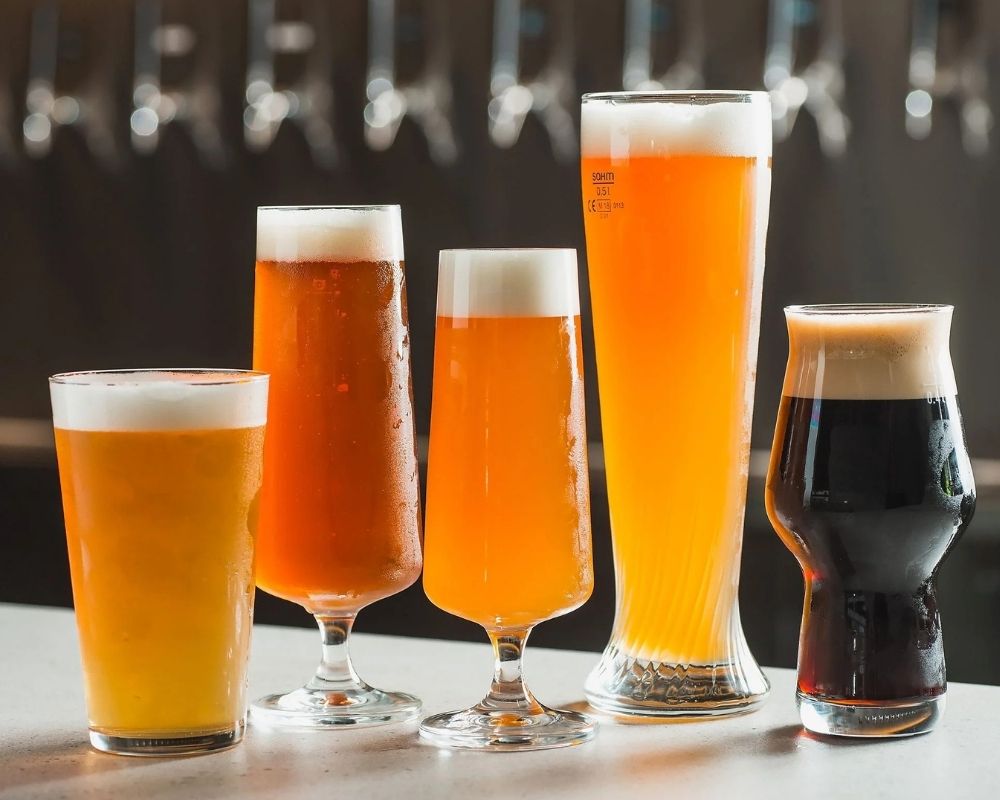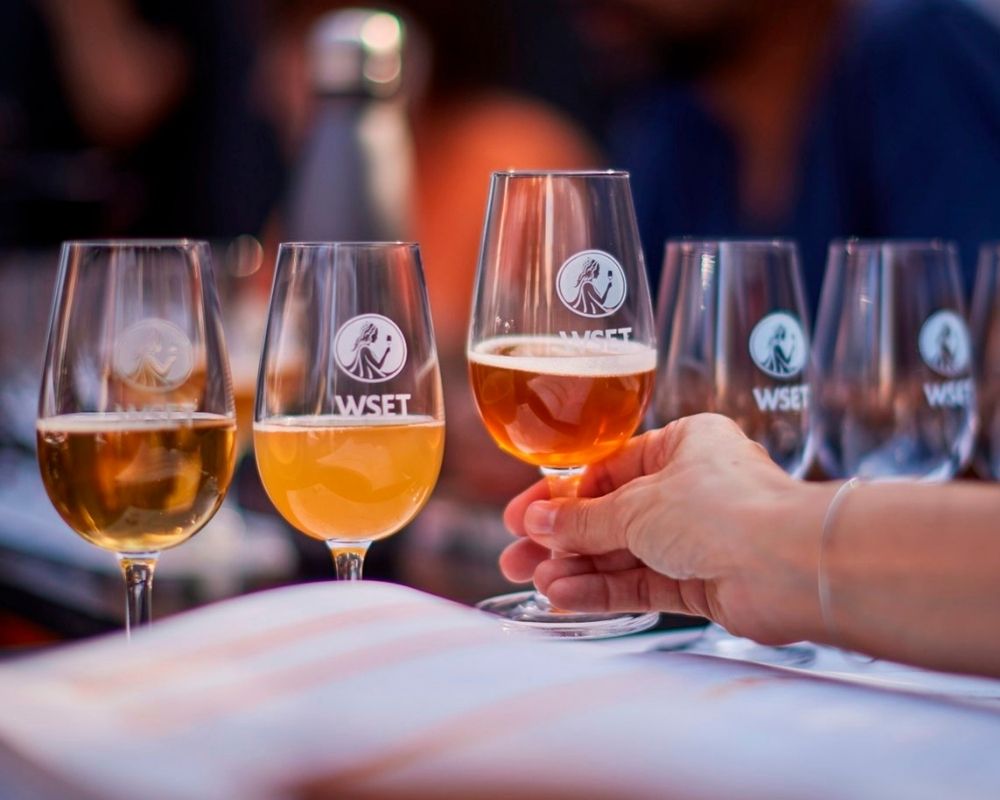Beer is much more than just a refreshing drink – it is a rich and complex universe, combining tradition, craftsmanship, and creativity.
Whether you are a curious enthusiast or an aspiring professional in the wine and spirits industry, understanding beer in all its dimensions – from artisanal brewing to expert tasting – allows you to develop a refined palate and enjoy every sip to its fullest.
From malt and hops to yeast and fermentation techniques, each ingredient and every step of production contributes to the unique flavor, aroma, and texture of beer.
There are countless styles to explore: blondes, ambers, browns, IPAs, or special barrel-aged beers, offering endless richness for both enthusiasts and professionals.
At Weeno, we support both amateurs and professionals in gaining a deep understanding of beer through our certified WSET courses, combining theory, hands-on practice, and guided tastings.
Whether your goal is to explore craft beers, refine your tasting skills, or build a career in the beer industry, our courses provide internationally recognized expertise.
In this article, we guide you through everything you need to know about beer – its history, ingredients, brewing techniques, and the essential tips to taste it like an expert.
Get ready to discover a fascinating world where every bottle tells a story and every sip is a unique sensory experience.

1. The history of beer: from ancient origins to today
Beer is a cultural and historical treasure that has accompanied humanity for over 6,000 years.
Understanding its history helps to better appreciate its diversity, brewing techniques, and the rich flavors in every sip.
Origins: the birth of a brewing Art
The earliest traces of beer date back to ancient Mesopotamia, where people cultivated barley and wheat to create fermented beverages.
Beer played a major social and spiritual role, consumed during religious ceremonies and communal celebrations.
These early beers were very different from what we know today: often thick, cloudy, and rich in fermentation flavors.
The Middle Ages: monasteries and the mastery of fermentation
During the Middle Ages, European monasteries played a central role in perfecting recipes and fermentation techniques. Monks brewed beer for their own consumption and for local trade.
The introduction of hops added a new aromatic dimension and acted as a natural preservative, allowing beers to last longer.
This period gave rise to many classic styles, such as Belgian Abbey beers and German lagers.
Industrial Revolution: mass production and standardization
With the Industrial Revolution, brewing became mechanized and more consistent. Scientific advancements, especially the understanding of yeast and fermentation processes, allowed for the production of more stable and uniform beers.
Large-scale hop cultivation and pasteurization helped spread beer throughout Europe and America, making it accessible to a much wider audience.
Today: the rise of microbreweries and craft beers
In recent decades, beer has experienced a spectacular revival thanks to microbreweries and craft brewing.
Modern brewers experiment with ingredients, fermentation techniques, and barrel aging, creating an incredible diversity of styles and flavors.
From classic pilsners to bold IPAs, complex stouts, and oak-aged beers, each bottle tells a unique story.
Why understanding beer history matters
Knowing the history of beer allows you to:
- Recognize brewing traditions and their influence on modern styles.
- Understand technical and aromatic evolutions that define each beer.
- Develop an expert perspective, essential for tasting and appreciating both craft and industrial beers.
At Weeno, our WSET Beer courses help deepen your historical knowledge, enabling you to evaluate each style and appreciate its richness with precision.
Discover everything you need to know about the new WSET Beer program in this article.

2. The ingredients of Beer: the foundation of a unique taste
Beer owes its aromatic richness and wide range of flavors to its fundamental ingredients.
Understanding their role is essential for any enthusiast or aspiring professional aiming to master the art of brewing.
Water: the main ingredient
Water makes up to 95% of beer, and its mineral composition directly affects the final taste. The levels of calcium, magnesium, and bicarbonates can enhance sweetness, bitterness, or the beer’s body.
Brewers sometimes adjust the water to achieve specific flavor profiles, as seen in Czech pilsners or Irish stouts.
Malt: the source of body and sweetness
Malt, usually made from germinated and roasted barley, is responsible for the beer’s color, body, and sweet aromas.
Pale malts provide notes of bread or biscuit, while roasted or caramel malts offer hints of chocolate, coffee, or caramel. The choice of malt allows brewers to create the unique aromatic palette of each beer.
Hops: balance and aromatics
Hops balance the malt’s sweetness with natural bitterness and enrich beer with floral, fruity, or resinous notes. They also act as a natural preservative, helping the beer last longer.
Different types of hops and the timing of their addition during brewing greatly influence the final aromatic profile.
Yeast: the engine of fermentation
Yeast is the catalyst for fermentation, transforming malt sugars into alcohol and carbon dioxide. It also contributes to specific aromas, ranging from fruity and spicy notes to more neutral ones depending on the type of yeast used.
The choice of yeast is crucial for the beer style: ales, lagers, lambics, or mixed-fermentation beers.
Additional ingredients: creativity and diversity
Beyond the four classic ingredients, brewers sometimes add:
- Wheat or rye: for a lighter texture and slightly spicy taste.
- Fruits, spices, or honey: to create aromatic and original beers.
- Wood or flowers: for barrel-aged beers with complex profiles.
These additions allow brewers to reinvent traditional styles and offer unique tasting experiences with every sip.
For both tasters and professionals, knowing the role of each ingredient allows you to:
- Identify characteristic aromas and flavors during tasting.
- Appreciate the differences between industrial and craft beers.
- Develop an expert perspective capable of evaluating a beer’s quality and style.

3. The brewing process: step by step
Brewing beer is a meticulous process where each step directly influences the final taste, aroma, and texture.
Understanding these steps is essential for any enthusiast or professional seeking to master the art of brewing.
3.1 Malting: preparing the grains
Malting is the first stage of brewing.
Barley grains are:
- Soaked to stimulate germination.
- Germinated, activating natural enzymes needed to convert starch into sugar.
- Dried using warm air or roasted to halt germination.
This stage determines the beer’s color, body, and sweet aromas. Different types of malt—pale, caramel, or roasted—allow brewers to create a diverse aromatic palette, from biscuit to chocolate notes.
3.2 Mashing: extracting the sugars
During mashing, malt is crushed and mixed with hot water, forming the wort. This step allows brewers to:
- Extract fermentable sugars, essential for alcohol production.
- Define the beer’s color and texture.
- Develop initial aromas, which form the foundation of the final flavor profile.
The choice of temperature and mashing time directly affects the beer’s sweetness, body, and aromatic richness.
3.3 Boiling and adding hops: bitterness and aromatics
Next, the wort is boiled, which:
- Sterilizes the liquid, eliminating unwanted microorganisms.
- Allows the addition of hops, balancing the malt’s sweetness with natural bitterness.
The type of hops, timing of addition, and boiling duration influence:
- Bitterness (IBU) depending on the beer style.
- Aromatic notes, from floral and fruity to resinous.
3.4 Fermentation: alcohol is born
Once cooled, the wort is inoculated with yeast, which transforms sugars into alcohol and carbon dioxide.
- Top fermentation: Used for ales, it is fast and aromatic, producing beers with fruity and spicy notes.
- Bottom fermentation: Used for lagers, it is slower and milder, resulting in light and clean beers.
Fermentation is crucial for developing the characteristic aromas of each style and determining the alcohol content.
3.5 Maturation: refining the flavors
After fermentation, the beer is left to mature, often from several weeks to months, depending on the style.
This step allows brewers to:
- Smooth the texture and integrate aromas.
- Develop complex and balanced flavor notes.
- Prepare the beer for filtration and packaging in bottles or kegs.
Maturation ensures that every beer achieves its optimal roundness, freshness, and aromatic complexity, providing a superior tasting experience.

4. The main beer styles
Beer stands out for its incredible diversity of styles, each offering a unique aromatic profile, color, and texture. Understanding these styles is essential for discerning tasting and appreciating the art of brewing.
4.1 Blonde beers: light and refreshing
Blonde beers are generally clear and easy to drink.
- Profile: Light, mild, often slightly sweet.
- Aromas: Cereal, pale malt, sometimes floral or fruity notes.
- Ideal for: Summer, aperitifs, and light meals.
Blonde beers are an excellent starting point for discovering beer without being overwhelmed by bitterness.
4.2 Brown beers: rich and malty
Brown beers are characterized by their dark color and rich aromatic complexity.
- Profile: Pronounced malt, fuller body.
- Aromas: Caramel, chocolate, coffee, sometimes dried fruits or spices.
- Ideal for: Enthusiasts of complex flavors and more generous beers.
These beers often reveal surprising depth, especially after some years of maturation.
4.3 Amber beers: balanced and round
Amber beers offer a perfect balance between malt and hops.
- Profile: Balanced sweetness and bitterness, medium body.
- Aromas: Caramelized malt, fruity or toasted notes.
- Ideal for: Those looking for an aromatic yet accessible beer, perfect to pair with a variety of dishes.
4.4 IPA (India Pale Ale): hops and intensity
IPAs are known for their strong hop character and intense aromas.
- Profile: Pronounced bitterness, medium to light body.
- Aromas: Citrus, tropical fruits, resinous, floral notes depending on the hops used.
- Ideal for: Lovers of bold and aromatic beers who enjoy exploring the complexity of hops.
4.5 Special and craft beers: creativity and originality
Special beers encompass all the innovative creations from craft brewers:
- Fruit, spice, honey, or even barrel-aged beers.
- Unique and often surprising aromatic profiles.
- Ideal for: Discovering unprecedented tasting experiences, appreciating the brewer’s creativity, and varying flavors.
These beers demonstrate that the beer universe goes far beyond the classics, offering endless combinations of malt, hops, yeast, and original ingredients.

5. Beer tasting: developing your palate
Tasting beer is more than just drinking it.
It is a sensory art that involves perceiving its full range of aromas, texture, and balance. Developing your palate allows you to better appreciate each beer and understand the brewer’s craftsmanship.
The 5 key steps of beer tasting
1. Observe the color and clarity
Examine the beer’s appearance in the light. The color reveals the type of malt used and the intensity of the flavors. Clarity indicates filtration and freshness of the product.
2. Smell the primary and secondary aromas
Inhale the beer to identify malt, hop, fruit, floral, or spice aromas. This step unveils the aromatic complexity and the beer style.
3. Taste to identify balance
Take a sip and let it circulate in your mouth. Note the balance between malt and hops, the body, bitterness, and sweetness.
4. Note the finish and length
Observe how long the flavors linger after tasting. A high-quality beer offers a harmonious and long finish, indicative of its complexity.
5. Compare with other styles
Taste multiple beers to refine your palate and learn to distinguish nuances between styles, ingredients, and brewing techniques.
At Weeno, our WSET-certified beer courses teach you to taste like a professional, recognize the subtleties of each beer, and develop an expert palate. You will learn to identify the key characteristics of every style and understand how production methods and ingredients influence the tasting experience.
You can already start exploring systematic beer tasting techniques through the WSET approach, building the foundation for a truly professional beer tasting experience.

6. Storage, serving, pairing, and cocktails: the art of elevating beer
Beer is more than just its production: proper storage, serving, and gastronomic pairings are essential to unlock its full potential.
Storage and serving
Ideal temperature: Each beer style has its perfect tasting temperature, from 4–6°C for light lagers to 12–14°C for dark or strong beers, to fully reveal their aromas and structure.
Optimal storage: Keep bottles away from light and temperature fluctuations to preserve freshness and original taste.
Perfect serving: A clean, appropriate glass, poured at an angle to create optimal foam, enhances the sensory experience.
Food and beer pairing
Pairing beer with food is an art:
- Light blond beers with fish, salads, or fresh cheeses.
- Dark or amber beers with roasted meats, chocolate desserts, or aged cheeses.
- Hoppy IPAs with spicy dishes or Asian cuisine to balance intensity and bitterness.
Check out our Instagram post where we shared 3 surprising beer pairing ideas that work every time!
Beer in cocktails
Beer is also a creative base for cocktails: shandies, micheladas, or fruit- and spice-infused beers. These combinations reveal a new aromatic dimension and delight curious, gourmet audiences.

Mastering beer and unlocking its potential
Beer is much more than a refreshing drink: it is a rich universe where history, ingredients, brewing techniques, and diverse styles come together to offer unique experiences.
Mastering tasting, serving, storage, food pairings, and even beer-based cocktails allows you to develop an expert palate and a deep understanding of each bottle.
At Weeno, our WSET Beer courses provide you with all the keys to becoming a knowledgeable connoisseur, whether you are a passionate enthusiast or a professional in the field.
You will learn to:
- Identify the subtle aromatic and flavor notes of each beer.
- Pair beers with food for memorable culinary experiences.
- Create innovative cocktails and master perfect service.
Don’t let the potential of your beers go untapped: join our WSET Beer courses and transform every tasting into a moment of expertise and pleasure.
Book your next session at weenodrinksacademy.com and discover the fascinating world of beer in all its facets.






